Letters from Lodi
An insightful and objective look at viticulture and winemaking from the Lodi
Appellation and the growers and vintners behind these crafts. Told from the
perspective of multi-award winning wine journalist, Randy Caparoso.
Story of an appellation—Part 11, the state of Lodi today
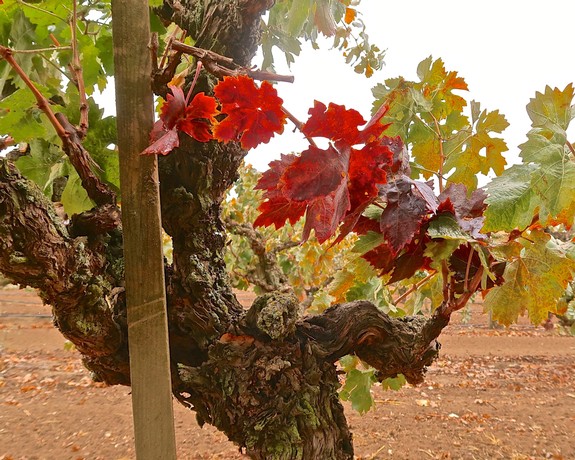
November colors in Mokelumne River-Lodi Carignan, originally planted on its own roots in 1900.
Continued from Story of an appellation—Part 10, Lodi's modern day winemaking leaders
Point in history
There have been a few hiccups during Lodi's transition to higher-quality wine grapes over the past forty to fifty years. For instance, Zinfandel—California's most enduring heritage grape for the production of dry table reds—was primarily utilized to produce mildly sweet pink wine (i.e., White Zinfandel) during the 1980s and 1990s.
Although the White Zinfandel craze did not exactly enhance Lodi's reputation as a wine region of quality, it did help preserve the region's existing plantings of the grape—many of them over 50 or as much as 100 years old—and kept growers from pulling out these heritage Zinfandel blocks in favor of popular "new" varieties such as Chardonnay or Merlot.
If not for White Zinfandel, we may not be able to describe Lodi, as we do today, as the region with the most old vine plantings (that is, vineyards planted over 50 years ago) in the country.
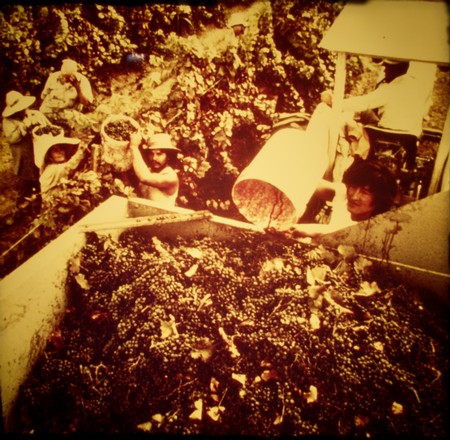
Lodi grape pickers during the 1970s. San Joaquin Historical Museum.
Lodi is not just the "Zinfandel Capital of the World"—by dint of the fact that over 40% of California's Zinfandel production is still grown in Lodi—but is also the "Old Vine Capital of America." There is more acreage of old vines in Lodi than anywhere else in the country.
The outsized role of old vines today
Times change, and old vines are a much bigger deal than ever; even more than just twenty, thirty years ago when "Old Vine" on labels started to become a smart marketing tag. The UK-based Old Vine Registry, officially launched just this past October 2023, spells out the significance of old vines to the modern-day wine industry all around the world:
Primarily, saving old vines is not a romantic endeavor, it is addressing a planetary crisis. It’s a question of sustainability, first and foremost. Old vines carry the secrets of survival and have adapted to stress over decades and even centuries. They are often more resilient in times of drought and heatwave, they have learned to live with or develop immunity to pests and diseases, and they have survived extreme weather events.
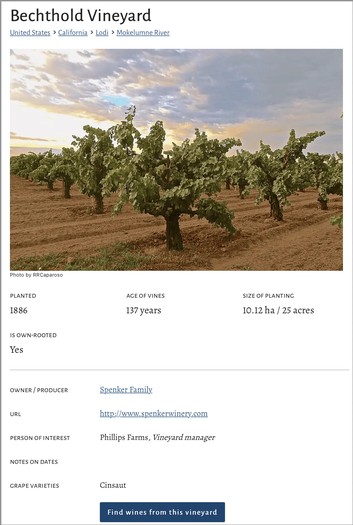
Old Vine Registry entry summarizing Lodi's Bechthold Vineyard (own-rooted Cinsaut planted in 1886).
Old vines are also much more adapted to the soils they’re planted in and therefore more resilient. Unlike young vines, they don’t need irrigating and they need less, if any, chemical inputs to survive. Old vineyards are also often full of clonal diversity and rare varieties. The genes of old vines can be studied, and old vine material can be propagated for more resilient young vines.
In addition, these big, gnarly vines are significant reservoirs of biomass and carbon; they play vital roles in local hydrological cycles; their old, deep-and-wide root networks are inextricably bound up with and connected to the mycorrhizal networks that sustain, feed, and protect our soils. Old vines are also linked to social sustainability in terms of retaining, preserving, celebrating, recognizing, respecting, and dignifying tradition, old wisdom, handed-down knowledge, experience, and the people who are an integral part of that.
Old vines, in other words, are teaching the international wine industry how to sustain and improve over the long term. While it was never a "master plan," Lodi's role in this will only become bigger.
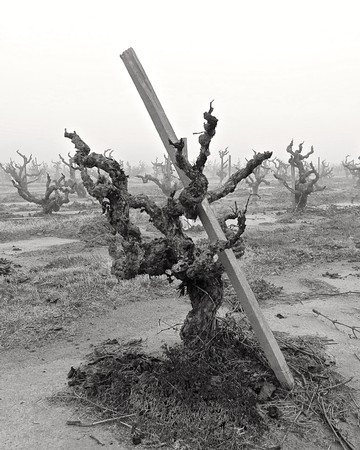
Ancient vine Zinfandel in Marian's Vineyard, one of the first Lodi vineyards to be bottled as a single vineyard premium varietal during the 1990s.
Sense of identity
When the Lodi Winegrape Commission was founded in 1991 as a self-imposed consortium of growers dedicated to the promotion and improvement of the Lodi grape-growing industry, old vine Zinfandel was obviously the category of wine that the entire region could hang its hat on. Since then, two other things have happened:
1. Producers of Lodi Zinfandel, based in and outside of Lodi, began producing red wines with more and more sensory qualities distinct and unique to Lodi, as opposed to qualities meant to duplicate the taste of Zinfandels from other regions. This has enhanced the positive side of this particular identity—that is, an identification with distinct, high quality, artisanal styles of Zinfandel (as opposed to strictly cheap, barely above jug level Zinfandels).
2. Lodi growers and wineries have learned to hang their hats on numerous other wine grapes besides Zinfandel, in lockstep with the market’s steadily growing thirst for more variation of product and increasingly higher quality wines in general.
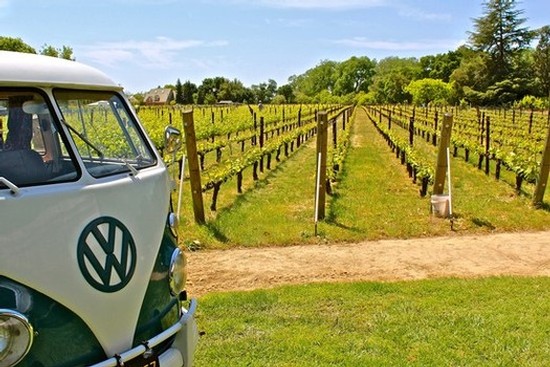
Mother block of Albariño, Tempranillo, and Graciano cultivars in Bokisch's Las Cerezas Vineyard, planted in the late 1990s.
Locally, for example, there are now more brands of Albariño and Tempranillo than there are of Chardonnay and Cabernet Sauvignon. The latter two varietals may be the most popular market categories in the country, but in Lodi Albariño and Tempranillo are an even bigger deal, mainly because these grapes are better adapted to the local terroir.
Make a mistake, though, most of the grapes grown in Lodi still go into value-priced wines made by the big or giant producers. In the post-World War II years and up through the 1960s, these used to be sweet fortified wines. Since the mid-1970s, the value-priced categories have been dominated by dry table wines.
All the same, the premium wines made by small, independent, handcraft wineries still play only a small part of Lodi's wine-growing industry. The vast majority of grapes into the pipelines feeding giant companies such as Woodbridge by Robert Mondavi, or “parent” producers of numerous popular sub-brands, such as those of E. & J. Gallo, Constellation's former Sebastiani brands, The Wine Group/Franzia and Trinchero Wine Estates/Sutter Home.
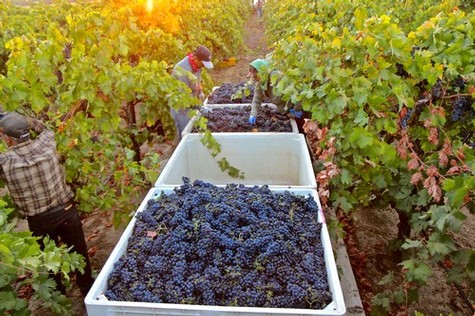
Zinfandel harvest in Cemetery Vineyard, an east side Mokelumne River-Lodi block originally planted to supply the White Zinfandel market and now utilized to produce premium varietal reds, occasionally as vineyard-designate wines.
The consumer is aware of this, which has given Lodi a reputation for ordinary wines. Identity, however, is a different matter. Identity is what drives progression. As with all emerging wine regions, identity is invariably forged by the finest or most interesting wines coming out of each respective region. It has taken a while, but Lodi has also been burnishing a reputation for top-quality wines, especially the increasing number crafted by smaller, artistic, or terroir-conscious producers.
With respect to the latter objectives, vintners produce wines that taste like they come from vineyards in Lodi, rather than just emulating varietal expectations (which can come from anywhere) or replicating brand styles.
There are not a lot of independent wineries in Lodi itself, but it's been enough to forge an identity tangible enough to exert some changes in the region's overall reputation. Out of the 50 or so bonded wineries operating as brick-and-mortar in Lodi today, all but a handful produce well less than 30,000 cases a year, and most of them less than a third of that.
Anyone who is cognizant of how wine regions grow knows how reputations are made. Fifty years ago, for example, the vast majority of grapes grown in Sonoma County and Napa Valley went to either giant wineries like E. & J. Gallo or into the $8-$9 wines of big brands such as Charles Krug, Louis M. Martini or Sebastiani. In those days, the top-quality wines from those regions may have added up to less than 1%, but it's the top-quality wines that have forged the reputation and identity of these regions ever since then.
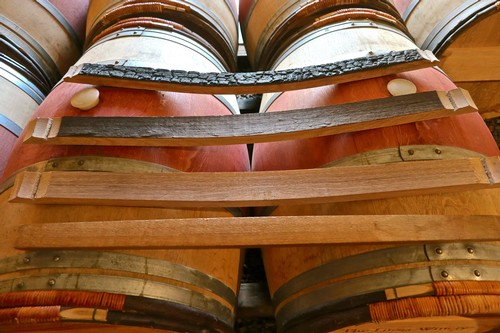
French oak barrels in The Lucas Winery, the second of Lodi's modern-day independent wineries specializing in single-vineyard handcraft Zinfandel meant to taste like its Lodi origin rather than a typical varietal style of Zinfandel.
Put it another way: Wineries such as E. & J. Gallo and Sebastiani never sourced from Sonoma County and Napa Valley to produce their value-priced wines because these are ordinary, low, or average-quality wine regions. They sourced these grapes because these are great wine regions.
If anything, no region's reputation or identity grows out of wishful thinking. When it comes to the possibility of producing fine wine, it always comes down to "place." You either have it or you don't.
The finer Lodi-grown wines now being produced are impressive for the same reason why grapes like Flame Tokay and Zinfandel have always been able to thrive in the region: Lodi’s mild Mediterranean climate and well-drained soils are highly conducive to Vitis vinifera, the classic European family of wine grapes.
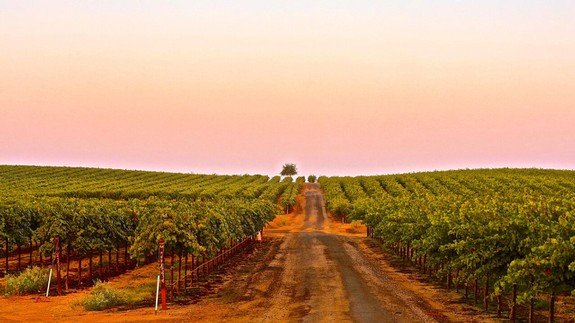
Hillside vineyard in Lodi's Borden Ranch, planted in the early 2000s as part of the appellation's push into the lower Sierra Nevada foothills, making Lodi the largest grower of wine grapes in the country.
Consumer tastes may have evolved considerably since 1900, but good terroir is still good terroir, and Lodi has plenty of good terroir. These are the exact same circumstances that prompted growers to make the transition from crops such as wheat and watermelons to table and wine grapes back in the late 1800s, and these are the exact same circumstances that explain why Lodi is the largest winegrowing region in the United States today.
The exact same circumstances explain why there are more old vines in Lodi than anywhere else in the country, and why there is more variety of wine grapes grown in Lodi than in any other region in the United States.
There is a reason, and that reason is because Lodi is a great winegrowing region, whether or not the rest of the world has caught on to that fact.
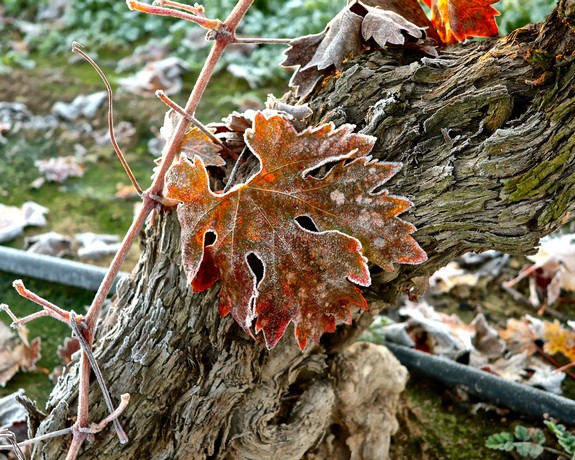
Old vine Mokelumne River-Lodi Zinfandel on a frosty December morning.